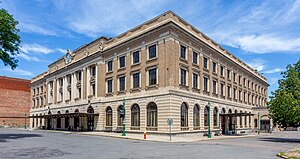Boehlert Transportation Center Utica, NY | |||||||||||||||||||||||||||||||||||||||||||||||||||||
|---|---|---|---|---|---|---|---|---|---|---|---|---|---|---|---|---|---|---|---|---|---|---|---|---|---|---|---|---|---|---|---|---|---|---|---|---|---|---|---|---|---|---|---|---|---|---|---|---|---|---|---|---|---|
 Utica Union Station in 2021 | |||||||||||||||||||||||||||||||||||||||||||||||||||||
| General information | |||||||||||||||||||||||||||||||||||||||||||||||||||||
| Location | 321 Main Street Utica, New York United States | ||||||||||||||||||||||||||||||||||||||||||||||||||||
| Coordinates | 43°06′15″N 75°13′41″W / 43.1041991°N 75.2281117°W | ||||||||||||||||||||||||||||||||||||||||||||||||||||
| Owned by | Oneida County | ||||||||||||||||||||||||||||||||||||||||||||||||||||
| Line(s) | Empire Corridor (Mohawk Subdivision) Adirondack Railroad | ||||||||||||||||||||||||||||||||||||||||||||||||||||
| Platforms | 1 side platform, 1 island platform | ||||||||||||||||||||||||||||||||||||||||||||||||||||
| Tracks | 3 | ||||||||||||||||||||||||||||||||||||||||||||||||||||
| Connections | |||||||||||||||||||||||||||||||||||||||||||||||||||||
| Construction | |||||||||||||||||||||||||||||||||||||||||||||||||||||
| Parking | Yes | ||||||||||||||||||||||||||||||||||||||||||||||||||||
| Accessible | Yes | ||||||||||||||||||||||||||||||||||||||||||||||||||||
| Other information | |||||||||||||||||||||||||||||||||||||||||||||||||||||
| Station code | Amtrak: UCA | ||||||||||||||||||||||||||||||||||||||||||||||||||||
| IATA code | ZUA | ||||||||||||||||||||||||||||||||||||||||||||||||||||
| History | |||||||||||||||||||||||||||||||||||||||||||||||||||||
| Opened | April 1914[1] | ||||||||||||||||||||||||||||||||||||||||||||||||||||
| Rebuilt | 1978 | ||||||||||||||||||||||||||||||||||||||||||||||||||||
| Passengers | |||||||||||||||||||||||||||||||||||||||||||||||||||||
| FY 2023 | 65,867[2] (Amtrak) | ||||||||||||||||||||||||||||||||||||||||||||||||||||
| Services | |||||||||||||||||||||||||||||||||||||||||||||||||||||
| |||||||||||||||||||||||||||||||||||||||||||||||||||||
| |||||||||||||||||||||||||||||||||||||||||||||||||||||
Union Station | |||||||||||||||||||||||||||||||||||||||||||||||||||||
| Area | 1 acre (0.4 ha) | ||||||||||||||||||||||||||||||||||||||||||||||||||||
| Architect | Stem & Fellheimer | ||||||||||||||||||||||||||||||||||||||||||||||||||||
| Architectural style | Beaux Arts | ||||||||||||||||||||||||||||||||||||||||||||||||||||
| NRHP reference No. | 75001215[3] | ||||||||||||||||||||||||||||||||||||||||||||||||||||
| Added to NRHP | April 28, 1975 | ||||||||||||||||||||||||||||||||||||||||||||||||||||
| |||||||||||||||||||||||||||||||||||||||||||||||||||||
The Boehlert Transportation Center at Union Station is a train station served by Amtrak and the Adirondack Railroad in Utica, New York. It is owned by Oneida County, and named for retired U.S. Rep. Sherwood Boehlert (R-New Hartford).
The station was built in the Italianate style and includes a rusticated granite first story with buff brick above. Symmetrically rectangular in plan, there are thirteen bays across the façade and fifteen on the side elevations. A brick parapet crowns the building; over the main entrance is a large clock flanked by eagle sculptures. The Utica station was added to the National Register of Historic Places in 1975.[4]
Inside is a restaurant and a barber shop, one of the few barber shops in a train station today.[5] The 15,000-square-foot (1,400 m2) waiting room's 47-foot-high (14 m) vaulted ceiling is supported by 34 marble columns. The station's blueprints called for the importing of columns that originally adorned Grand Central Terminal in New York City.[clarification needed] Twelve large benches are heated by steam pipes and vents incorporated into the benches themselves.[6]
A total of eight Amtrak trains use the station daily: two trains (one eastbound, one westbound) on the Lake Shore Limited, four trains (two in each direction) on the Empire Service, and two trains (one in each direction) on the Maple Leaf. In addition, the Adirondack Railroad operates a heritage railway from Utica to Holland Patent, Remsen and Thendara, New York, terminating in Tupper Lake on a seasonal basis.[7]
- ^ "UNION STATION, MAIN ST, UTICA NY". Cultural Resource Information Resource. State of New York. Retrieved October 17, 2018.
- ^ "Amtrak Fact Sheet, Fiscal Year 2023: State of New York" (PDF). Amtrak. March 2024. Retrieved June 29, 2024.
- ^ "National Register Information System". National Register of Historic Places. National Park Service. July 9, 2010.
- ^ "Utica Station". Amtrak's Great American Stations. Archived from the original on June 4, 2012. Retrieved November 10, 2014.
- ^ Union Station Barber Shop on Facebook
- ^ Harold D. Eberlin (1914), "Recent railway stations in American cities", Architectural Record, vol. 36, pp. 122–145, hdl:2027/uc1.b3065973, retrieved June 7, 2021
- ^ Utica's Union Station (Adirondack Scenic Railroad) Archived February 6, 2015, at the Wayback Machine
